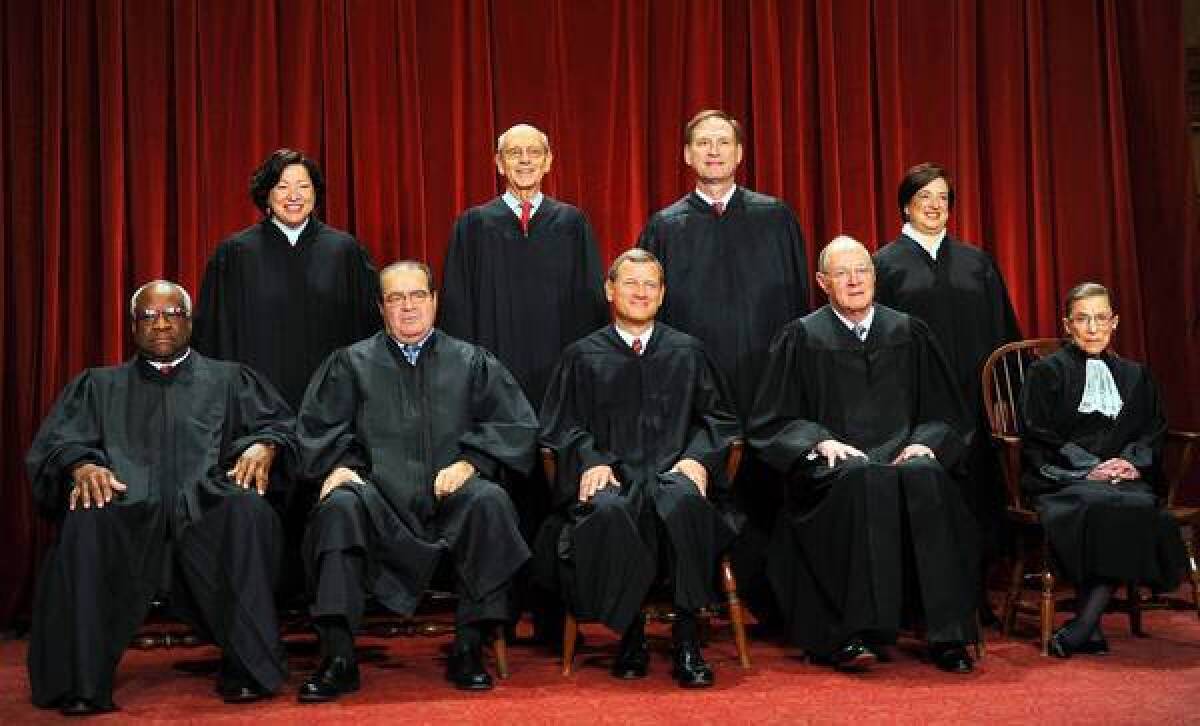Supreme Court becomes Roberts court in year of surprises

- Share via
Washington Bureau
WASHINGTON — The Supreme Court had more than its share of surprising opinions and unexpected rulings this year beyond the pair of victories for the Obama administration in the healthcare and immigration cases.
The justices ruled for the criminal defendants in this term’s most important cases on crime and punishment. That alone is a rarity for a court that more often leans to the right.
Overall, however, the decisions this year did not reflect a true ideological shift at the high court. Instead, they arose from shifting coalitions, sometimes the result of one justice taking an unexpected stand.
In the last week of the term, the Roberts court was truly born, even though Chief Justice John G. Roberts Jr. was finishing his seventh year. Until this year, Justice Anthony M. Kennedy always played the role of decider in the cases where the conservatives and liberals were evenly split.
But in the healthcare case, Roberts split with the conservatives and joined with the court’s four liberals to uphold President Obama’s signature law.
There were similar, if far less dramatic, examples throughout the term.
In one notable opinion, conservative JusticeSamuel A. Alito Jr., joined by the four liberals, said the right to privacy protects Americans from having all of their movements tracked by cellphones or other electronic devices. The government previously maintained that the Constitution’s protection against “unreasonable searches” did not extend to surveillance on public streets and sidewalks.
The court also gave defendants new rights during plea bargains. About 95% of criminal cases end not with a verdict from a jury, but in a deal between a prosecutor and the defendant. Prosecutors had maintained that because no one had a right to a plea deal, no one’s rights were violated if a defendant passed up a good deal because of a gross mistake by his lawyer.
But in March, the court announced a new rule in a pair of 5-4 opinions by Kennedy. The right to an “effective” lawyer includes the right to minimally competent advice during a plea deal, he said.
For the third time in eight years, the court by a 5-4 vote put new limits on the punishment of juvenile offenders. Kennedy has been the leader here as well.
The high court declared mandatory sentencing laws requiring life prison terms without parole for murderers to be unconstitutional for defendants who are under age 18 at the time of their crimes, giving hope to about 2,000 prisoners. These inmates do not have a right to go free, the justices said, but they do have a right to hearing so a judge or jury can decide whether life in prison is the proper punishment for a defendant who is as young as 14.
The justices also ruled that crack cocaine defendants could be sentenced under a new, more lenient measure passed in 2010, even if their crimes took place before it became law.
Even corporations facing criminal fines won new legal protections. In the past, the court said defendants had a right to have the jury decide the key facts that called for a harsher punishment. A 6-3 opinion in June by Justice Sonia Sotomayor said the same was true for corporations.
In one major setback for defendants, the court in a 5-4 decision refused to bar strip searches of new inmates entering a county jail, even if the inmates were not seen as dangerous. The majority said guards cannot know for sure who might try to sneak weapons or drugs into a jail.
It was certainly “a better-than-expected year for criminal defendants,” said Steven Shapiro, legal director for the American Civil Liberties Union.
Conservatives had their share of victories as well. The justices on the right served notice that they would make it harder for public-sector unions to collect fees from employees to pay for special political drives. The union would first need the “affirmative consent” of a nonmember, Alito said in a 5-4 opinion.
The court also said the Constitution demanded “special solicitude” for churches in dealing with their employees, an opinion that could figure in the flap between the Obama administration and Catholic bishops over contraceptive coverage.
But the most surprising development was the role played by Roberts.
“I really believe this is the year it became the Roberts court,” said Erwin Chemerinsky, UC Irvine law dean.
In the healthcare and immigration cases, the chief justice surprised both sides by joining with the liberal bloc. Kennedy, left in dissent, would have struck down the entire healthcare law.
The ruling left a residue of anger on the right, and leaks from the right side of the court accused Roberts of having switched his position during the deliberations.
What is unclear is whether Roberts’ search for a middle ground on healthcare — and the harsh retribution from the right — will have a lasting effect.
In the fall, the court is set to revisit the constitutionality of race-based affirmative action in a case from the University of Texas. The justices also will decide the fate of the Defense of Marriage Act and are likely to reconsider part of the Voting Rights Act that authorizes special oversight for much of the South.
Conservatives hope the Roberts court will strike down affirmative action and limit the Voting Rights Act but uphold the marriage act, which defines marriage as between one man and one woman. To win all three, however, they will need the steady support of Chief Justice Roberts.
More to Read
Sign up for Essential California
The most important California stories and recommendations in your inbox every morning.
You may occasionally receive promotional content from the Los Angeles Times.











